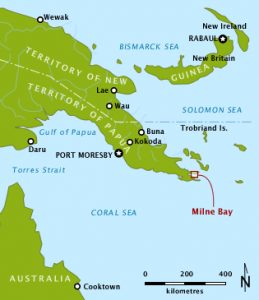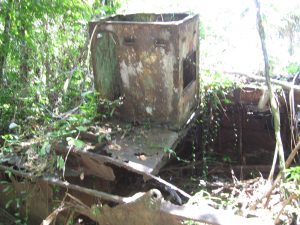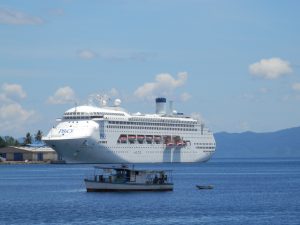- Author
- Editorial Staff
- Subjects
- WWII operations, History - WW2
- Tags
-
- RAN Ships
- None noted.
- Publication
- June 2014 edition of the Naval Historical Review (all rights reserved)
The Naval Historical Society is not here to promote the travel industry, but in this instance it may be warranted, as some members may be interested. A recent initiative by P & O Cruises Australia provides reasonably priced and comfortable tours to Papua New Guinea with access to areas with plenty of naval history.
This large country, now home to all 7 million of our immediate neighbours and fought over by our forefathers, is largely unknown to the current generation. In 2013 the first exploratory 10 day cruise was by MV Pacific Dawn sailing from Brisbane with a call at Townsville and then three places in PNG. A subsequent cruise in the same year omitted Townsville and visited Alotau, the capital of Milne Bay Province, Kitava and Kiriwina islands in the Trobriand Group, Rabaul in New Britain and, finally, Doini Island at the southern end of the China Strait. Four similar cruises are planned in 2014 and the following year the itinerary is being expanded to 14 days to include Madang and Kavieng in New Ireland.
Pacific Dawn – 70,000 gross tons, registered in London and now based in Brisbane – was built in Italy and delivered in 1991 as Regal Princess. Following a refurbishment in Singapore she came to our shores in 2007 as Pacific Dawn. She now carries 2,000 passengers and 720 crew under an Italian captain. There is only one Australian in the ship’s company, which possibly says much about the parlous state of our maritime industry with uncompetitive labour rates. When asked about having female officers onboard, the Captain provided an eloquent Latin style response: ‘The integration of male and female officers is a good thing as it helps temper the passion of the males’.

There is much to be learned from the logistics capability and rapid turnaround of this ship, which in a very short time can discharge her passengers and process their baggage through customs, health, immigration and security and then work the reverse process of taking on another full house. There is also waste to be disposed of ashore, many tons of supplies to be loaded and the ship fuelled. All this is achieved with minimal fuss in a turnaround of eight hours. It is indeed a pity that some of these skills could not be learned by RANR personnel for potential transfer to the RAN in time of need.
Milne Bay
Captain (later Rear Admiral) John Moresby, RN in HMS Basilisk, a paddle sloop of 1,710 displacement tons, was responsible for surveying much of the area around the extensive harbour of Milne Bay, which he named after Admiral (later Admiral of the Fleet) Sir Alexander Milne who was First Sea Lord of the Admiralty. Port Moresby is named after Admiral Sir Fairfax Moresby who was John Moresby’s father.
The main aim of Moresby’s surveys was searching for a shorter route between Australia and China. In this he was successful, discovering and charting the China Strait off the southeast tip of Papua. In time this led to a profitable trading post being established in the Strait on picturesque Samarai Island. Cooled by sea breezes from the north and south, it was known as the ‘Paradise of the Pacific’. Because of its small size the island was heavily populated and developed excellent infrastructure with the unheard of luxury of electricity being installed in 1927. Early in 1942, with the threat of a Japanese invasion, Samarai was evacuated and most of the infrastructure destroyed with the administration relocating to Port Moresby and that required for war-time service moved to the western end of Milne Bay, where defensive positions were being established.
Battle of Milne Bay
A check of past issues of the Naval Historical Review and our sister publication the Journal of Australian Naval History reveals that neither has featured an article on Milne Bay. This is possibly because the Allied cause was served by land and air with some maritime support, whereas that of the Japanese was principally a maritime operation with some air support. A balanced approach indicates some naval perspective is required, acknowledging the days belonged to Allies with air superiority but the nights to Japanese cruisers and destroyers.
The strategic significance of Milne Bay was that it could dominate the vital eastern sea lanes between Australia and New Guinea. The Japanese saw the capture of Milne Bay airfields as an opportunity to take Port Moresby and harass the shipping lanes between the United States and Australia. In May 1942 the Allied Commander-in-Chief, General Douglas MacArthur, requested that Australian troops take up defensive positions around airfields to be established at Milne Bay. These would permit an air offensive to be carried out deep into enemy controlled territory and provide a protective screen for Port Moresby.
Australian Army forces which built up to two brigades were mainly concentrated around Gili Gili, where Major General Cyril Clowes established his headquarters. The first troops arrived in Milne Bay from Port Moresby on 25 June 1942 in the Dutch merchantmen Karsik and Bontekoe, escorted by HMA Ships Ballarat and Warrego. Gili Gili was chosen for headquarters owing to the abundance of buildings constructed by Lever Brothers (soap manufacturers) who operated one of the world’s largest coconut plantations there, with access to a small wharf.
With the assistance of American Engineers work quickly commenced on the construction of temporary airstrips using steel mats (Marsden or more correctly Marston Matting) and in late July, RAAF Squadrons 75 and 76 were established using the formidable P-40 Kittyhawks. While work was interrupted by Japanese air attacks, these were largely repulsed by the now large Allied presence which included anti-aircraft fire. Of far greater concern was the weather, with frequent heavy rain downpours leading to impassable tracks and the scourge of malaria.
The Battle of Milne Bay which took place between 25 August and 07 September 1942 was a short battle of relatively small scale. However its importance should not be underestimated as it was the first time on land that the invincibility of Japanese troops had been checked and defeated, a great boost to Allied morale. The intended Japanese attack was to be a two-pronged seaborne landing to capture the airfields at Milne Bay and thereby open up a route to attack Port Moresby. Because of faulty intelligence and now lack of mastery of the skies, all did not go well with this planned invasion.
While there had been frequent small-scale air attacks on 24 August, the defending troops received the first of three concentrated waves of attacks by Zero fighters. This was preliminary to the landing next day from a convoy of nine ships carrying 1,171 men of the 5th Kure and 5th Sasebo Special Naval Landing Forces, plus some logistic support to take care of provisions which included the landing of two small tanks. While the force had been sighted and slightly damaged by Allied aircraft, bad weather prevented a major air attack prior to their landing on the evening on the 25 August. Unfortunately, whether by design or accident, the Japanese had used a local from Milne Bay as a guide. He landed them far to the east of the airfields, making further progress extremely difficult. Their landing barges were later discovered by Allied aircraft and destroyed. The native guide was to pay with his life for this mistake.

Another group of 353 troops of the 5th Sasebo Special Naval Landing Force was making its way in seven barges from Buna. Overnight they called at Goodenough Island, where again their barges were discovered and destroyed by Australian aircraft. The troops were stranded far from their destination. This had a devastating impact on the future of the Japanese attack. Finally, Japanese reinforcements of a further 800 troops were ordered to Milne Bay but, with the position ashore being untenable, these were later withdrawn.
With their minimum force the Japanese pressed on through appalling conditions towards the airstrips. As the Allies controlled the skies, movement and fighting was mostly at night. Many a wounded man on both sides never saw their opponents. The advance was made as far as the first airstrip where the enemy tried in successive waves to overpower the defenders. This was to no avail and in the morning all that could be seen was large numbers of Japanese dead. In one last hurrah, late at night on 6 September Japanese cruisers entered the bay and with searchlights illuminated the Dutch merchantman Anshun and the hospital ship Manunda. The former was sunk at her moorings but the latter remained unscathed. After this a shore bombardment of Allied positions was conducted, with minimal casualties. The following day it was all over, with the Japanese withdrawing their badly depleted forces.
Was Milne Bay one of the decisive battles of WW II in the Pacific? There is no easy answer. Given the overwhelming superiority of Allied forces of 9,000 (only half were infantry and many of these were inexperienced Militia) against 1,200, it is difficult to see how the Japanese could succeed. However, they were battle hardened and determined troops and if they had reached the airfields and found more reinforcements, the situation could have been precarious. It was however a victory to the Allies, the first against Japanese on land and a great morale booster. In total the Allies lost about 180 men killed but the Japanese losses of 700 men were unsustainable. From this point onwards the tide was turning. It would be interesting to speculate if our roles had been reversed whether this defeat would have been regarded in the same light as another Dunkirk or Gallipoli.
Major General Clowes, nicknamed ‘Silent Cyril’, had seen service at Gallipoli and on the Western front where he won an MC and was awarded a DSO and, in more recent times, he had commanded ANZAC troops in Greece. No one doubted his ability as a soldier and he was a fine but cautious commander. Being a man of few words he did not believe in troubling his superiors with superfluous messages when there was nothing to report. The ‘silence’ and lack of positive news so infuriated that master of spin MacArthur that after the battle Clowes was removed from his command and never again saw active service.
Possibly not recognised at the time was the importance of this action and the contribution made by Major General Clowes. He was promoted Lieutenant General in 1949 on his retirement from the Army. A final analysis belongs to our eminent post-war Governor-General, Field Marshall Sir William Slim, who in his memoirs concerning his experiences as Commander of Commonwealth Forces engaged against the Japanese in Burma, says: Some of us may forget that of all the Allies, it was the Australians who first broke the spell of the invincibility of the Japanese Army.
Milne Bay Today
After the battle Allied aircraft and warships were able to operate from Milne Bay, clearing the coastline and islands to the northwards in preparation for further troop advances. For a short period Milne Bay became an important naval outpost, with over 50 naval moorings established off Gili Gili with an RFA tanker based there to refuel ships. In 1943 the shore establishment HMAS Lavada was established there but as the war advanced it was closed two years later. The island of Samarai was once more revived but never recovered its former glory. In 1968 it was replaced as the provincial capital by the new town of Alotau on the northern shores of Milne Bay, a site once occupied by the Japanese. Samarai has been placed on PNG’s list of national historic sites and is gradually being preserved with the aim of making this a future tourist destination.

As most of the relics of WW II have now rusted away there is not much to be seen. Some remnants of Marsden Matting were discovered re-used as a garden fence. The only physical reminder of the Japanese landing is a few forlorn rusting ribs from one or more of their Daihatsu landing craft. As the Daihatsu was well regarded, its design influenced that of similar but later American craft. By a stroke of fate, a little further up the coast and some distance inland are the remains of a small flotilla of eleven of those Pacific workhorses, the Landing Craft Mechanized (LCM). As these arrived too late in the campaign to be of immediate use they were hauled inland and camouflaged. Here they remain after 70 years of peacefully rusting away. In a few more years the jungle will reclaim them all.
The islands of the Milne Bay Province, many of which had short war-time histories, remain a delight as to date they are unspoilt and not commercialised. Opening them to the cruise industry will undoubtedly bring some economic benefits but at a price, disturbing their precious charm and tranquillity. While anchored off the Trobriand Islands it was interesting to speculate upon the protection of trade when observing the large number of passing coal carriers with their cargoes from the Bowen Basin to South East Asia.
Memorial Service
On this voyage Pacific Dawn had a reasonably sized contingent of ex-Servicemen and their families, some of whom organised with P & O for a memorial service to be held in honour of those who remain behind on this now mostly forgotten battlefield. On leaving the China Strait a commemoration service was held in perfect conditions, the setting ablaze with a vermilion washed tropical sunset. To officiate it was fortunate that amongst the passengers were two priests including ex-RAAF chaplain Bob Heathwood. Mention was made of three other passengers who had served so many years ago at Milne Bay:
Private Jim Downie of the Independent Transport Company,
Private Bill Sharman of the 7th Field Ambulance Unit,
Able Seaman George Stewart a telegraphist in the strangely named stores ship HMAS Whang Pu.
The service ended with wreaths laid upon the calm waters of the Strait.
The Voyage Continues
In the next edition of this magazine we intend running a complementary article looking at Rabaul a century after an Australian Naval and Military Expeditionary Force occupied this former German territory.




